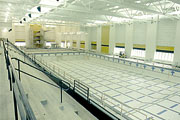
The new Purdue Aquatic Center is a design masterpiece by Scholer Corp. (Lafayette, IN), the architect and engineering firm for the 79,000-sq-ft project. The facility, which is used for athletic competition, recreation, and educational purposes, features a 50-m poured concrete/tile surface pool, diving pool, 12-person spa, locker rooms, plus permanent seating for 600 spectators, and temporary seating space for an additional 800.
The HVAC system is state-of-the-art as well and includes five Dectron Internationale Dry-O-Tron(r) DB-182 heat recovery dehumidifiers that were installed by mechanical contractor, Freitag-Weinhard. Heisserer Beiriger Associates (HBA), an Indianapolis-based manufacturers' representative, provided the Dectron equipment for the project. Scholer's innovative air distribution system was installed by local contractor A to Z Sheet Metal.
Moisture minimization
Dectron custom manufactured the dehumidifiers to include a multitude of functions over and above typical commercial dehumidifier operation. The dehumidifiers remove 215 lb of moisture/hr each to maintain the natatorium's rh at 50% while simultaneously heating the pool water to 82 degrees F through a patented heat recovery process, according to Tom Yee, vice president/mechanical engineer at Scholer. Yee specified factory-installed steam coils that take Purdue's central plant-generated steam to supplement the natatorium's 84 degrees space heating, when needed.Customized features and options include 100% outside air purge for use during routine superchlorination periods, an economizer for free cooling, air-cooled condensers for A/C, and controls compatible with the campus EMS.
Another customized feature is higher-efficiency, 60% bag filters for improved IAQ. Because the filters create more resistance, Yee also calculated necessary fan motor hp upgrades and other affected parameters. "Basically, we specified custom-made units that HBA helped facilitate at the factory," Yee added.
Additionally, sizing of the equipment was difficult because of the varying moisture, cooling, and heating loads in the space. Yee arrived at the total moisture-removing capacity of 1,075 lb/hr and the project's total 140,000 cfm by designing for the worst-case scenario of 1,400 spectators combined with various diving, swimming, and spa activities. Automatic controls modulate control valves and dampers to maintain water temperature, space temperature, and space humidity setpoints.
Underdeck, fiberglass-reinforced, plastic ductwork bathes the perimeter walls and windows with warm, dry air from the dehumidifier to eliminate any condensation formation. Exposed overhead, custom-fabricated, 65- by 40-in., flat oval, aluminum duct is mounted approximately 40 ft high (65 ft high in the diving well area) and supplies the pool and spectator areas. Conditioned air is delivered to the spectator areas for comfort, and the air is distributed to prevent stagnation and stratification.
No big chill
Since chilling effects due to supply air velocities are always a concern in natatoriums, the air distribution system was designed to minimize air velocities at the pool deck level. In addition, air was not directed toward the pool water surface to minimize the evaporation rate of the water.Odors and moisture are prevented from penetrating the building's lobby, offices, and other nonpool areas because Scholer designed the air distribution system with a slight negative pressure in the natatorium, through the use of exhaust fans. Although the dehumidifiers provide a total heat recovery strategy, the exhaust fans exhaust some air to create the negative pressure.
Chloramines collection is always problematic as well in natatorium air distribution. Scholer devised a dual return-air system consisting of underdeck duct that returns 25% of the air at the pool deck level where chloramines concentration is the greatest.
Three Taco shell-and-tube heat exchangers ranging from 1.3 to 1.8 MBtu serve as backup pool water heating in the event of system shutdown. Separate air handlers cool auxiliary areas such as locker rooms, the lobby, and the fitness room. Scholer's air distribution design also includes the introduction of some 7,000 cfm (minimum) of outside air/unit, which surpasses the ASHRAE standards of 15 cfm/person. Outside air dilutes indoor contaminants and maintains acceptable IAQ.
Additional concerns involved more than air distribution. To be effective, all natatorium designs must incorporate vapor barriers to protect the building envelope. Scholer's engineering and architectural team paid particularly strict attention to sealing the many intersecting planes of the natatorium and accompanying diving well, to safeguard against any moisture penetration.
While the Purdue Aquatic Center is aesthetically appealing, the behind-the-scenes operation supports the visual aspect of the facility. "Foremost, we wanted good IAQ and an energy recovery HVAC system for energy conservation," said Yee. ES
